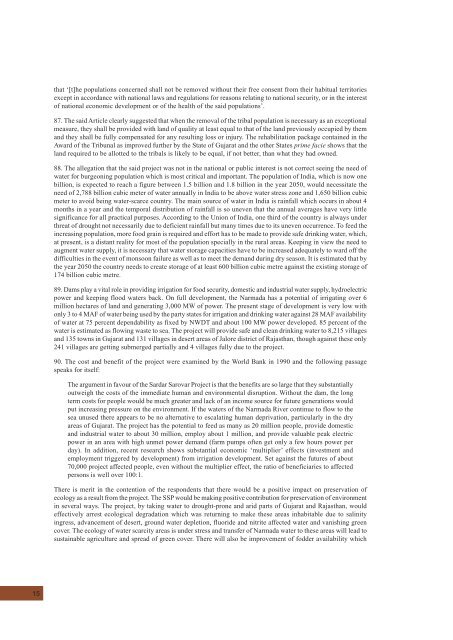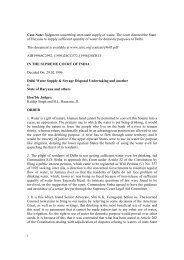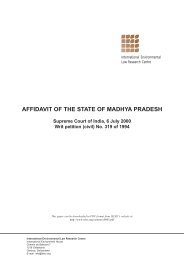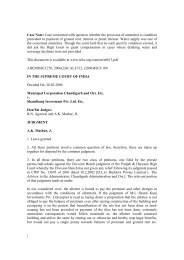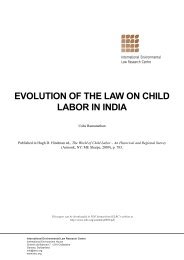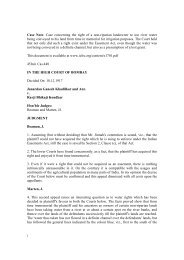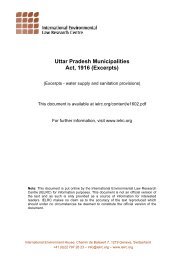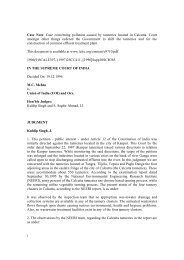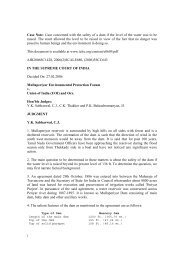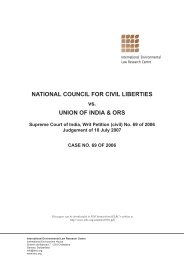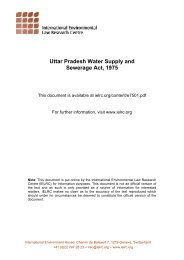Narmada Bachao Andolan vs. Union of India - International ...
Narmada Bachao Andolan vs. Union of India - International ...
Narmada Bachao Andolan vs. Union of India - International ...
Create successful ePaper yourself
Turn your PDF publications into a flip-book with our unique Google optimized e-Paper software.
that ‘[t]he populations concerned shall not be removed without their free consent from their habitual territoriesexcept in accordance with national laws and regulations for reasons relating to national security, or in the interest<strong>of</strong> national economic development or <strong>of</strong> the health <strong>of</strong> the said populations’.87. The said Article clearly suggested that when the removal <strong>of</strong> the tribal population is necessary as an exceptionalmeasure, they shall be provided with land <strong>of</strong> quality at least equal to that <strong>of</strong> the land previously occupied by themand they shall be fully compensated for any resulting loss or injury. The rehabilitation package contained in theAward <strong>of</strong> the Tribunal as improved further by the State <strong>of</strong> Gujarat and the other States prime facie shows that theland required to be allotted to the tribals is likely to be equal, if not better, than what they had owned.88. The allegation that the said project was not in the national or public interest is not correct seeing the need <strong>of</strong>water for burgeoning population which is most critical and important. The population <strong>of</strong> <strong>India</strong>, which is now onebillion, is expected to reach a figure between 1.5 billion and 1.8 billion in the year 2050, would necessitate theneed <strong>of</strong> 2,788 billion cubic meter <strong>of</strong> water annually in <strong>India</strong> to be above water stress zone and 1,650 billion cubicmeter to avoid being water-scarce country. The main source <strong>of</strong> water in <strong>India</strong> is rainfall which occurs in about 4months in a year and the temporal distribution <strong>of</strong> rainfall is so uneven that the annual averages have very littlesignificance for all practical purposes. According to the <strong>Union</strong> <strong>of</strong> <strong>India</strong>, one third <strong>of</strong> the country is always underthreat <strong>of</strong> drought not necessarily due to deficient rainfall but many times due to its uneven occurrence. To feed theincreasing population, more food grain is required and effort has to be made to provide safe drinking water, which,at present, is a distant reality for most <strong>of</strong> the population specially in the rural areas. Keeping in view the need toaugment water supply, it is necessary that water storage capacities have to be increased adequately to ward <strong>of</strong>f thedifficulties in the event <strong>of</strong> monsoon failure as well as to meet the demand during dry season. It is estimated that bythe year 2050 the country needs to create storage <strong>of</strong> at least 600 billion cubic metre against the existing storage <strong>of</strong>174 billion cubic metre.89. Dams play a vital role in providing irrigation for food security, domestic and industrial water supply, hydroelectricpower and keeping flood waters back. On full development, the <strong>Narmada</strong> has a potential <strong>of</strong> irrigating over 6million hectares <strong>of</strong> land and generating 3,000 MW <strong>of</strong> power. The present stage <strong>of</strong> development is very low withonly 3 to 4 MAF <strong>of</strong> water being used by the party states for irrigation and drinking water against 28 MAF availability<strong>of</strong> water at 75 percent dependability as fixed by NWDT and about 100 MW power developed. 85 percent <strong>of</strong> thewater is estimated as flowing waste to sea. The project will provide safe and clean drinking water to 8,215 villagesand 135 towns in Gujarat and 131 villages in desert areas <strong>of</strong> Jalore district <strong>of</strong> Rajasthan, though against these only241 villages are getting submerged partially and 4 villages fully due to the project.90. The cost and benefit <strong>of</strong> the project were examined by the World Bank in 1990 and the following passagespeaks for itself:The argument in favour <strong>of</strong> the Sardar Sarovar Project is that the benefits are so large that they substantiallyoutweigh the costs <strong>of</strong> the immediate human and environmental disruption. Without the dam, the longterm costs for people would be much greater and lack <strong>of</strong> an income source for future generations wouldput increasing pressure on the environment. If the waters <strong>of</strong> the <strong>Narmada</strong> River continue to flow to thesea unused there appears to be no alternative to escalating human deprivation, particularly in the dryareas <strong>of</strong> Gujarat. The project has the potential to feed as many as 20 million people, provide domesticand industrial water to about 30 million, employ about 1 million, and provide valuable peak electricpower in an area with high unmet power demand (farm pumps <strong>of</strong>ten get only a few hours power perday). In addition, recent research shows substantial economic ‘multiplier’ effects (investment andemployment triggered by development) from irrigation development. Set against the futures <strong>of</strong> about70,000 project affected people, even without the multiplier effect, the ratio <strong>of</strong> beneficiaries to affectedpersons is well over 100:1.There is merit in the contention <strong>of</strong> the respondents that there would be a positive impact on preservation <strong>of</strong>ecology as a result from the project. The SSP would be making positive contribution for preservation <strong>of</strong> environmentin several ways. The project, by taking water to drought-prone and arid parts <strong>of</strong> Gujarat and Rajasthan, wouldeffectively arrest ecological degradation which was returning to make these areas inhabitable due to salinityingress, advancement <strong>of</strong> desert, ground water depletion, fluoride and nitrite affected water and vanishing greencover. The ecology <strong>of</strong> water scarcity areas is under stress and transfer <strong>of</strong> <strong>Narmada</strong> water to these areas will lead tosustainable agriculture and spread <strong>of</strong> green cover. There will also be improvement <strong>of</strong> fodder availability which15


